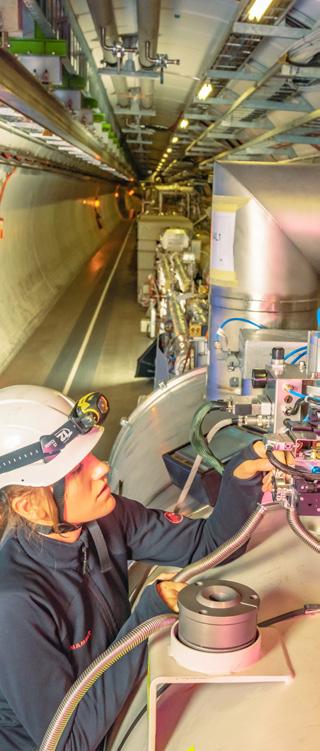
3 minute read
European Big Science organisations
Neutron sources for materials research
ESS – SWEDEN
Advertisement
ESS, (European Spallation Source) currently under construction in Lund, Sweden, will be a multidisciplinary research facility using the world’s most powerful neutron source, based on particle accelerators and spallation technology. ESS will provide neutron beams up to 100 times brighter than those currently available.
ISIS – UK
The ISIS pulsed neutron and muon source produces beams that allow scientists from academia and industry to study materials at the atomic level, using a suite of instruments often described as ‘super-microscopes’. ISIS plays a vital role in the portfolio of analysis techniques used by researchers in fields such as nanotechnology, pharmaceuticals, engineering, clean energy, and quantum computing.
ILL – FRANCE
ILL is a nuclear fission reactor that operates the most intense neutron source in the world, a 58.3 MW nuclear reactor designed for high neutron flux. Research using the beams focuses primarily on fundamental science in a variety of fields, including condensed matter physics, chemistry, biology, nuclear physics, and materials science.
Radiation facilities
MAX IV – SWEDEN
The MAX IV Laboratory is a synchrotron light facility, whose beamlines provide modern X-ray spectroscopy, scattering/diffraction, and imaging techniques. This is the world’s most brilliant synchrotron light source, capable of viewing material structures atom by atom. MAX IV facilitates discoveries of new structures at nano level, and scientists are able to monitor chemical processes in real time.
ESRF – FRANCE
ESRF is the world-leading source of synchrotron and a centre of excellence for fundamental and innovation-driven research for imaging and studying the structure of matter at atomic and nanometric scales in many fields. Visiting scientists conduct research using the X-ray beams that are 100 billion times more powerful than the X-rays used in hospitals.
DESY – GERMANY
DESY is a facility at which particle accelerators are used to investigate the structure of matter. Researchers explore the microcosm in all its variety – from the interactions of tiny elementary particles and the behaviour of new types of nanomaterials to biomolecular processes essential to life. Research fields range from nanomaterials and semiconductors to pharmaceuticals and materials for solar panels.
XFEL – GERMANY
European XFEL is the world’s most powerful X-ray laser facility, and is opening up completely new research opportunities for scientists and industrial users. The facility is powered by a 3.4-km linear accelerator, which can generate 27,000 X-ray flashes per second, each of a duration of less than 100 quadrillionths of a second.
Particle physics
CERN – SWISS/FRENCH BORDER
CERN (Organisation Européenne pour la Recherche Nucléaire) houses the world’s largest and most complex scientific instruments –purpose-built particle accelerators and detectors. These are used by scientists to advance the boundaries of knowledge regarding the origins of our universe and the basic constituents of matter, subatomic particles.
FAIR – GERMANY
FAIR, a facility for antiproton and ion research, is currently under construction. Matter that only exists in outer space will be produced in a lab for research, and FAIR will be able to accelerate ions of all the natural elements, as well as antiprotons. Experiments at the facility will advance technology in many areas, such as information and superconductor technology.
Fusion research
FUSION FOR ENERGY – SPAIN
F4E (Fusion for Energy) is the EU’s joint undertaking for ITER and the development of fusion energy. F4E is responsible for providing Europe’s in-kind and in-cash contribution to ITER. F4E works closely with industry and R&D organisations across Europe to design, manufacture, and test technical components for fusion installations.
ITER – FRANCE
ITER is a global project to build the world’s largest Tokamak for research into fusion energy. Experiments at the facility will advance fusion science and prepare the way for the fusion power plants of tomorrow.
ITER will be the first facility to integrate all the various technologies needed to operate a fusion reactor.

Ground-based space research
ESO – GERMANY/CHILE
ESO focuses on the design, construction, and operation of powerful ground-based facilities for astronomy. The observatory consists of telescopes at three sites in the Atacama Desert in Chile. The Very Large Telescope can view objects at the edge of our universe and help address fundamental questions.
EISCAT – SWEDEN
EISCAT conducts ionospheric and atmospheric measurements using a technique called ‘incoherent scatter radar’. EISCAT operates equipment in three countries – Finland, Norway, and Sweden – and all the facilities are located north of the Arctic Circle. The next-generation research radar facility, EISCAT_3D, is under construction, and will come into operation in 2023.
SKA – SOUTH AFRICA AND AUSTRALIA
The SKA Observatory is a next-generation radio astronomy-driven Big Data facility that will revolutionise our understanding of the Universe and the laws of fundamental physics. It will be the world’s largest radio telescope, with a collecting area of one square kilometre. These telescopes will position the SKAO as the leading research infrastructure for radio astronomy globally.
A designated member of the Big Science Sweden team is responsible for each facility, maintaining contacts, building relationships, and getting to know the facility’s organisation and needs.
FINLAND, NORWAY AND SWEDEN



